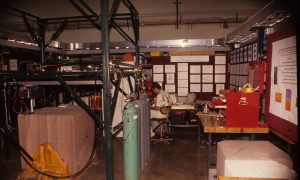Detailed information about the physical characteristics and material properties of the geologic medium is required to solve many of the applied problems routinely encountered in the petroleum, environmental, mining, and geotechnical engineering industries. The acquisition of such information through characterization activities is complicated by the fact that many of the important material properties are measured at scales much smaller than can be accomodated in current predictive models. For this reason, upscaling models are required for transforming information from the scale of the available data to the computational grid block scale. Numerous upscaling theories, representing a wide diversity of approaches, have been proposed; however, actual physical data to support these theoretical models are sparse and limited in scope.
The Flow and Transport Processes Lab performed systematic physical investigation of permeability upsacaling using a specially adapted mini-permeameter that we named the Automated Multiscale Permeameter (AMP) (Tidwell and Wilson, 1997). The AMP allows rapid, non-destructive, and precise measurement of rock matrix permeability at multiple sampling scales. A key feature of the AMP is its ability to acquire measurements at different scales according to consistent boundary conditions and flow geometry

At left in the photo is the Automated Multiscale Permeameter, collecting measurements from a block of Massilon sandstone
Measurements were made by compressing the permeameter tip-seal against a rock surface and injecting gas into the rock while measuring the flow rate and gas pressure from which the permeability is calculated, using a modified form of Dasrcy’s Law. The permeameter consists of four mass-flow meters of varying sensitivity, a pressure transducer, a barometer, and temperature sensor that are connected to a regulated source of compressed nitrogen (permeability range of 1×10-15 to 1×10-9 m2). A series of specially designed tip-seals, the diameter of which defined the scale of measurement, were used to establish a known boundary condition on the rock surface. Thus, by changing the size of the tip-seal, the permeameter examined volumes of rock ranging in scale from tenth to thousands of cubic centimeters. A soft, durable silicone rubber established the seal between the injection nozzle and the rock surface. To improve measurement precision and facilitate data collection, the gas permeameter was automated for laboratory use. Specially adapted PC-based software controlled operation of the electronic permeater instruments and solenoids. An x-y positioning system coupled with a pneaumatic piston was also automated for positioning and compressing the permeameter tip-seal against the rock surface. The system could perform more than 300 measurements in and 8 hour period, unattended.
Permeability upscaling was investigated by collecting large suites of permeability data over a range of discrete scales from blocks of rock (Tidwell, 1994). Systematic investigation of the influence of key porous media characteristics on upscaling behavior was approached through the careful selection of rock samples for analysis. For example, samples exhibiting different spatial structure (e.g., a massive, laminar bedded sandstone and cross-bedded sandstone samples) are investigated and the results compared. Ultimately, the measured data are used to test theoretical upscaling models and models of spatial variability.
Tidwell, V.C., and J.L. Wilson (1977), Laboratory method for investigating permeability upscaling, Water Resour. Res., 33(7), 1607-1616, doi:10.1029/97WR00804.